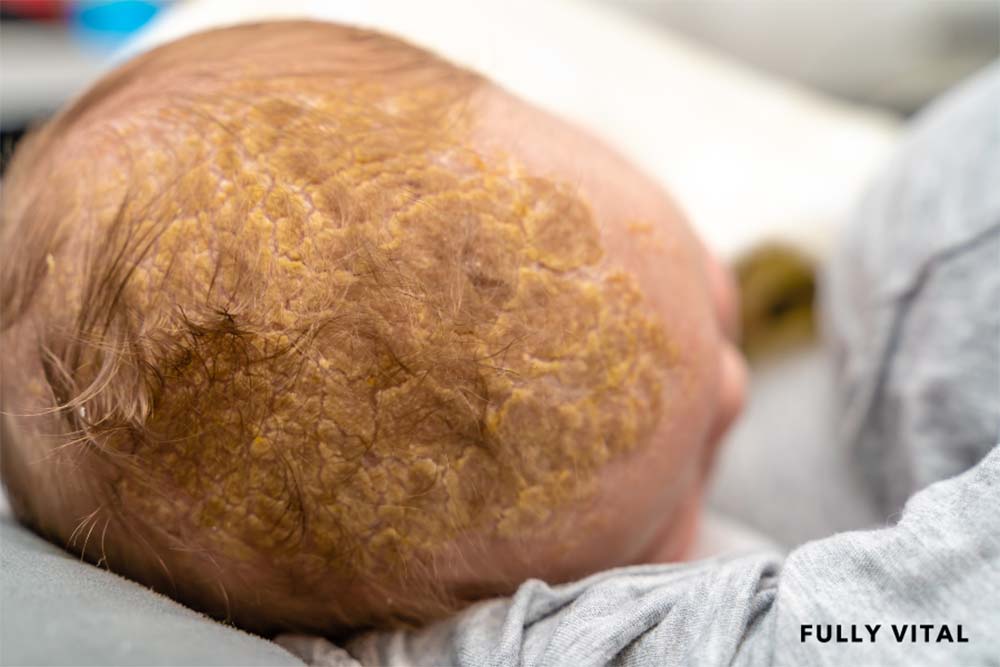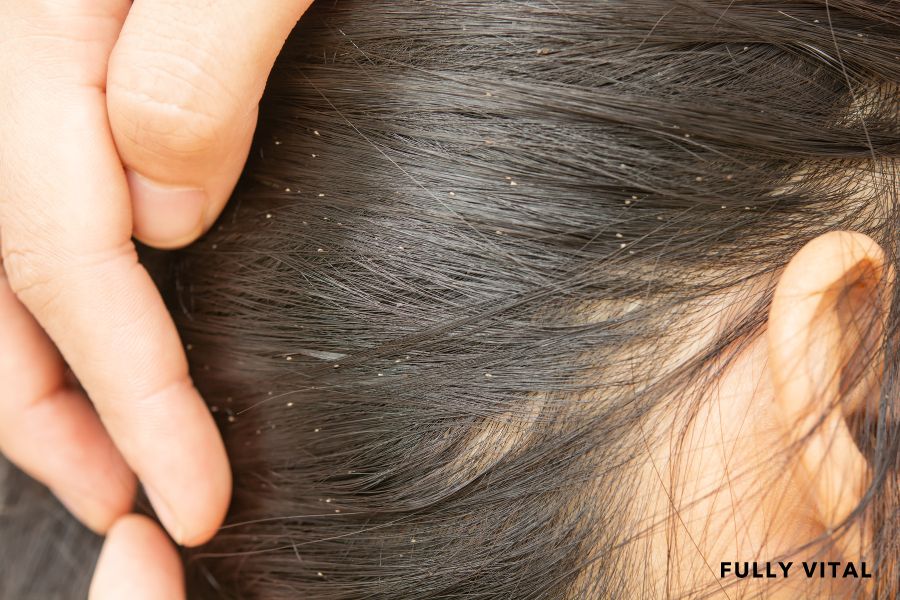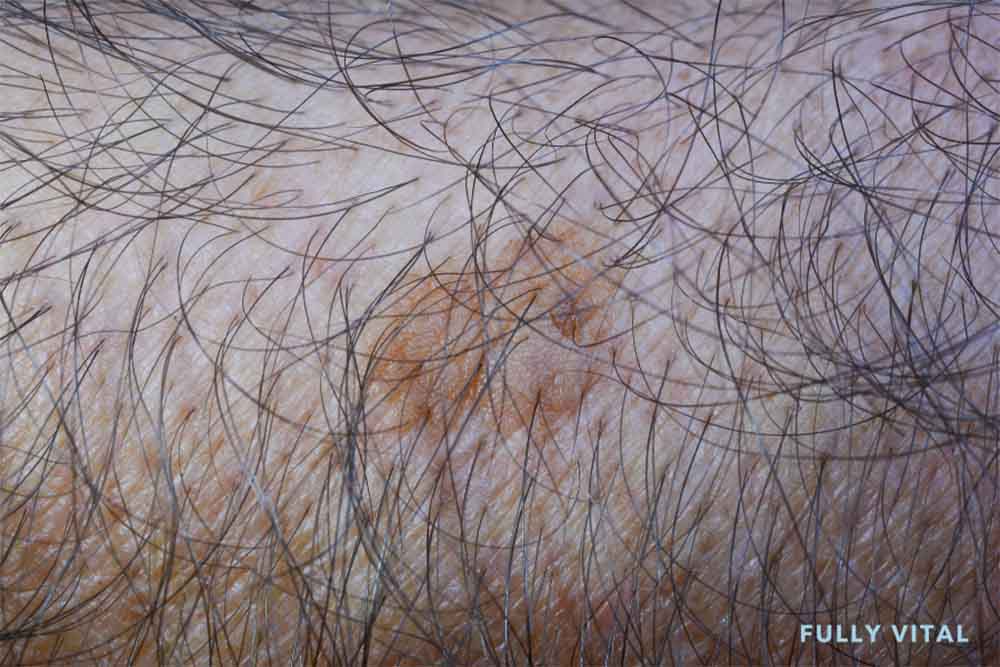
Unlocking The Secrets Of Cradle Cap: A Guide For Healthy Scalp And Hair Growth
Welcome to our in-depth exploration of cradle cap, a common scalp condition that can affect individuals of all ages.
In this article, we will unravel the significance of comprehending cradle cap, delve into its causes, and highlight the advantages of effective management.
Whether you're a concerned parent or an adult seeking solutions for scalp issues that could impact your journey to stimulate hair growth, you've come to the right place.

I LOVE MY HAIR NOW
FullyVital hair serum and hair vitamins made tremendous improvements in my hair. I truly love my hair now.
Dorit S.,
What Is a Cradle Cap?
Cradle cap, also known as seborrheic dermatitis, is a common skin condition that primarily affects the scalp.
It appears as flaky, crusty patches on the scalp, and sometimes, it can extend to other areas with high oil production, such as the face.1
Although it's most commonly associated with infants, cradle cap can occur in adults as well.

Why Is Understanding Cradle Cap Important?
Understanding cradle cap is crucial for several reasons.
Firstly, it helps alleviate unnecessary worries for parents of infants who might develop this condition.
Secondly, for adults, recognizing cradle cap can aid in distinguishing it from other scalp issues, thus guiding proper treatment.
How Does Cradle Cap Occur?
The exact cause of cradle cap isn't fully understood, but it's believed to be linked to overactive sebaceous glands and an overgrowth of yeast.2
These factors contribute to the production of excess sebum, which mixes with dead skin cells and forms the characteristic flakes and crusts.
What Are the Benefits of Managing Cradle Cap?
Managing cradle cap offers a range of benefits, including:
-
Promoting Healthy Hair Growth: By addressing the underlying scalp issue, you create an environment conducive to healthy hair growth.
-
Preventing Discomfort: Cradle cap can sometimes cause itchiness and discomfort. Effective management helps alleviate these symptoms.
-
Boosting Confidence: A clear and healthy scalp boosts self-confidence, allowing you to focus on your hair growth journey with positivity.
What Are Some Considerations In Treating Cradle Cap?
When it comes to treating cradle cap, keep the following considerations in mind:
Gentle Cleansing
Use a mild, hypoallergenic shampoo to gently cleanse the affected area.
Soft Brushing
Gently brush the scalp with a soft brush to help remove the flakes.
Natural Remedies
Some natural remedies, like coconut oil, can help moisturize the scalp and loosen the scales.
Medical Consultation
If cradle cap persists or worsens, consult a dermatologist for professional guidance.3
What Are Some Alternatives To Cradle Cap Treatment?
While many effective treatments exist, here are some alternatives you might consider:
Oatmeal Baths
Oatmeal baths can help soothe the scalp and reduce inflammation.
Petroleum Jelly
Applying petroleum jelly to the affected area can help soften and lift the scales.
Specialized Shampoos
There are shampoos formulated to target cradle cap, often containing ingredients like salicylic acid or ketoconazole.
What Is Cradle Cap Caused By?
Cradle cap is primarily caused by the interaction of overactive sebaceous glands and an overgrowth of yeast on the scalp.
This leads to an excess production of sebum, which combines with dead skin cells, resulting in the characteristic flaky patches.
What Are The Factors That Aggravate Cradle Cap?
Several factors can exacerbate cradle cap and prolong its presence:
-
Infrequent Cleansing: Inadequate washing can allow sebum and dead skin cells to accumulate.
-
Excessive Sebum Production: Overactive sebaceous glands contribute to the condition's development.
-
Yeast Growth: An abundance of yeast on the scalp can worsen cradle cap.
What Are The Signs Of Infected Cradle Cap?
Infected cradle cap may exhibit the following signs:
-
Redness: The affected area might appear redder than the surrounding skin.
-
Increased Irritation: Infected cradle cap is often itchier and more uncomfortable.
-
Pus or Fluid: Pimples or oozing fluid can indicate infection.
What Is The Effect Of Cradle Cap On Hair Growth?
Cradle cap itself does not necessarily halt hair growth.
However, the buildup of scales and potential irritation could indirectly affect hair health.
Proper management is key to maintaining a conducive environment for hair growth.
What Are Some Strategies To Eliminate Cradle Cap?
Managing cradle cap involves specific approaches to alleviate the condition:
Gentle Cleansing
Wash the scalp regularly with a mild, hypoallergenic shampoo.
Soft Brushing
Use a soft brush to gently remove scales and promote blood circulation.
Natural Remedies
Consider applying coconut oil or other natural moisturizers to soften and loosen scales.
Medical Consultation
Persistent or severe cases should be assessed by a dermatologist for professional guidance.
Does Cradle Cap Damage Hair?
Cradle cap itself typically doesn't directly damage hair.
It primarily affects the scalp's outermost layer, resulting in flaky patches and scales.
However, if left untreated or if the condition becomes inflamed or infected, it could potentially lead to hair breakage or affect the overall health of the hair.
Additionally, the buildup of scales and potential irritation might indirectly impact the hair's appearance and manageability.
What Is The Historical Context Of Cradle Cap?
-
Ancient Observations: Cradle cap's presence can be traced back through history, with references to similar scalp conditions in ancient medical texts.
-
Limited Understanding: Historically, the exact causes and management of cradle cap were less understood, often leading to misconceptions and ineffective treatments.
What Is The Current Landscape Of Cradle Cap?
-
Increased Awareness: In recent times, heightened medical knowledge and public awareness have led to a clearer understanding of cradle cap's nature and causes.
-
Research Advancements: Scientific research has shed light on the role of sebaceous glands, yeast, and skin health, contributing to more effective management strategies.2
-
Holistic Approaches: Current trends emphasize a holistic approach, considering not only symptom relief but also the overall health of the scalp and hair.
What Is The Future Of Cradle Cap?
-
Advancements in Treatment: Ongoing research is likely to unveil innovative treatment methods, leveraging technology and improved understanding of skin biology.
-
Tailored Solutions: Personalized skincare and haircare solutions may become more prevalent, allowing individuals to address cradle cap based on their unique needs.
-
Integration with Hair Growth: The future may see a deeper connection between cradle cap management and hair growth products, recognizing the impact of scalp health on hair vitality.
Unlock Youthful Hair With Fully Vital!Discover the secret to vibrant, youthful locks with Fully Vital's revolutionary hair growth products. Say goodbye to the effects of aging hair and hello to a healthier relationship with your precious strands. Our mission is to empower you with science-backed solutions that slow down and even reverse the aging process of your hair.
Experience the transformation that Fully Vital offers – a chance to preserve the beauty and allure of your hair for years to come. Your journey to youthful hair begins here. |
Final Thoughts On Cradle Cap
In our journey through the realm of cradle cap, we've uncovered the intricate layers of this scalp condition, understanding its origins, management, and potential impact on hair growth.
From its historical roots to the present state and the exciting prospects ahead, cradle cap has evolved from a mystery to a topic of significance in the hair care landscape.
As we've explored the connections between scalp health and hair vitality, it's evident that nurturing your scalp is an integral part of fostering luscious, vibrant hair.
At Fully Vital, we're dedicated to helping you unlock the potential of your locks by offering a variety of hair growth products designed to combat the effects of aging and promote a healthier relationship with your hair.
Remember, a healthy scalp is the foundation upon which your hair journey thrives.
By embracing the knowledge gained from this article and considering the holistic approaches we've discussed, you're on a path towards not only managing the cradle cap but also nurturing your hair's growth and radiance.
Here's to a future where healthy scalps and vibrant hair flourish.
Frequently Asked Questions About Cradle Cap
Can cradle cap lead to permanent hair loss?
Cradle cap doesn't typically lead to permanent hair loss.
Effective management can help maintain a healthy scalp environment for hair growth.
Is cradle cap contagious?
No, cradle cap is not contagious.
It's a benign skin condition caused by factors like sebum production and yeast growth.
Are there any home remedies I can try before seeking medical help?
Yes, gentle home remedies like using coconut oil or brushing with a soft brush can often help manage cradle cap.
However, consult a professional if it persists.
Is cradle cap the same as dandruff?
Cradle cap and dandruff share similarities, but they're not the same.
Dandruff usually occurs in older individuals and is linked to various factors, including yeast overgrowth.
Can adults develop cradle cap out of nowhere?
Yes, adults can develop a condition similar to cradle cap, known as seborrheic dermatitis.
It can appear seemingly out of nowhere and may require proper treatment.
What triggers cradle cap flare-ups?
Cradle cap flare-ups can be prompted by factors such as changes in weather, hormonal fluctuations, stress, or exposure to irritants.
Managing these triggers can contribute to better control over the condition.
Is olive oil safe for treating cradle cap?
While olive oil is often suggested as a remedy, it might not be the best option.
Olive oil can exacerbate cradle cap by further clogging pores.
Consult a dermatologist for safer alternatives.
Can a cradle cap spread to other parts of the body?
Yes, cradle cap can extend beyond the scalp to areas with high sebum production, such as the eyebrows, ears, or sides of the nose.
Prompt treatment can prevent its spread.
Are over-the-counter shampoos effective for cradle cap?
Over-the-counter shampoos designed to treat dandruff or seborrheic dermatitis can also aid in managing cradle cap.
Look for active ingredients like ketoconazole or salicylic acid.
Does the cradle cap cause itching?
Cradle cap can indeed cause itching, especially when the affected area becomes inflamed or infected.
Managing the condition can help alleviate discomfort and itching.
Sources:
-
Tucker, D., & Masood, S. (2020). Seborrheic Dermatitis. PubMed; StatPearls Publishing. https://www.ncbi.nlm.nih.gov/books/NBK551707/
-
Nobles, T., Harberger, S., & Krishnamurthy, K. (2022). Cradle Cap. PubMed; StatPearls Publishing. https://www.ncbi.nlm.nih.gov/books/NBK531463/
-
Lovászi, M., Szegedi, A., Zouboulis, C. C., & Törőcsik, D. (2017). Sebaceous-immunobiology is orchestrated by sebum lipids. Dermato-Endocrinology, 9(1). https://doi.org/10.1080/19381980.2017.1375636







